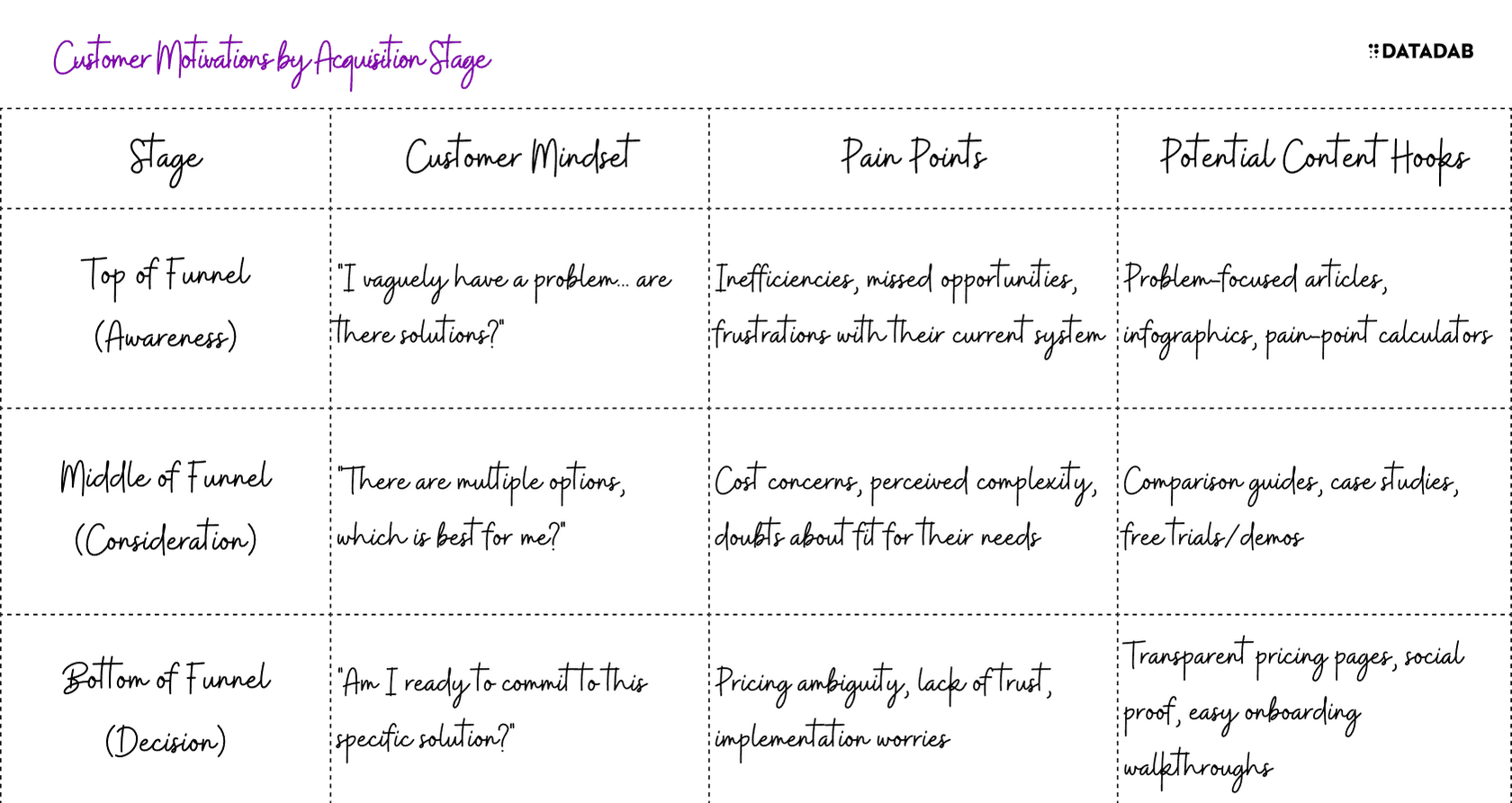Let's be honest, growing a business is tough. You might have a fantastic product, a passionate team... but somehow, those new customers aren't magically flocking to your door. I've been there myself, and that frustration fuels my obsession with getting this 'acquisition' thing right. No more empty promises, it's about building a customer acquisition machine that delivers measurable, profitable results.
While this introductory essay can't cover every detail, it serves to outline the essence of acquisition marketing, highlight key considerations, and demonstrate its impact.

Acquisition Marketing: More Than Just Ads

Many equate acquisition marketing with aggressive paid advertising; while such avenues remain part of the strategy, true acquisition marketing is far more sophisticated. It's an overarching mindset that guides all of your go-to-market efforts focused on the top of your funnel - from defining your buyer personas to post-sales onboarding. Let's break down why:
It's About the System, Not the Tactic: A single viral social media post won't generate an acquisition engine. Effective acquisition creates a self-sustaining machine that can outmatch competitors over time. It's not luck; it's deliberate strategizing, measuring, and adapting.
Full-Funnel Thinking: Unlike brand awareness, acquisition is laser-focused on tangible ROI: new customers. That means analyzing your entire buyer journey and how each touchpoint can be made not just engaging, but conversion-optimized.
Customer-Centricity: While 'acquisition' sounds transactional, its heart lies in deep customer understanding. Successful acquisition is a result of addressing needs even better than your buyers fully realize themselves.

The Stages of Acquisition Marketing Success
Let's visualize your acquisition marketing development through a maturity scale:
| Stage | Characteristics | Examples |
|---|---|---|
| Stage 1: Reactive & Opportunistic | Ad-hoc campaigns, focus on immediate signups/sales | A seasonal social media offer, a generic free trial |
| Stage 2: Metrics-Informed | Tracking KPIs basics, some customer segments identified | Running Facebook Ads targeted by age/location, measuring lead-to-sale conversion |
| Stage 3: Cohesive & Predictable | Data-driven, iterative improvement, consistent results | Integrated multi-channel strategy, using LTV & CAC for ad spend optimization |
| Stage 4: Proactive & Competitive | Sophisticated analytics, personalization, AI/ML models | AI-powered audience retargeting, deep look-alike analysis to identify new profitable segments |
Common Obstacles: Why Many Businesses Fail
Acquisition marketing is deceptively challenging. Common missteps include:
Fuzzy ROI: Vague vanity metrics (like impressions) vs. hard business data lead to misguided spending.
Mismatching Channels: If you don't intimately understand where your ideal customers congregate and consume information, you'll burn your budget in the wrong places.
Oversimplified Personas: Generic audiences yield generic results. The most profitable audience segments are unearthed through nuanced market research.
Leaky Funnel: Focusing solely on top-line signups misses opportunities to increase LTV (Lifetime Value) by improving your customer lifecycle post-acquisition.
Real-Life Acquisition Wins
Here's how companies used acquisition marketing to change their growth trajectory:
- MailChimp: The success of the email marketing giant hinged on its freemium model – an acquisition approach to convert free users to paying, while the product's virality generated further leads.
- HubSpot: HubSpot built a content marketing (and lead scoring) machine. Acquisition here doesn't solely rely on paid channels; it's the high-value educational materials leading to organic lead generation.
- Zapier: Strategic partnerships are powerful acquisition tools. Zapier grew aggressively by integrating with countless tools, exponentially expanding its reach through other products' existing user bases.
The SaaS Advantage (It's Not What You Think)
SaaS businesses stand to benefit immensely from well-executed acquisition marketing, but not solely due to the subscription-based revenue model. The true SaaS advantage lies in:
Data Richness: SaaS platforms generate abundant customer behavior data. This empowers advanced analytics, segmenting users beyond basic demographics - it's about identifying users on the cusp of a paid upgrade or finding patterns suggesting churn risk.
Iterative Potential: The ongoing nature of SaaS makes it ideal for agile testing. Shorten your feedback cycles to adapt messaging, experiment with pricing tiers, or test the impact of onboarding changes for improved conversion rates.
Viral Loops: Building referrals, social sharing, and gamified user incentives into your SaaS offers a highly scalable acquisition mechanism that traditional business models lack.

Key Acquisition Metrics that Matter (and Why)
While countless metrics can be tracked, the truly game-changing ones for acquisition are:
CAC (Customer Acquisition Cost): Put simply, how much does it cost to acquire a new customer? Keep a laser focus on how this varies across channels and customer segments.
LTV (Lifetime Value): Not all customers are equal. LTV reveals the long-term revenue potential of each acquired user. This is pivotal in maximizing your spend, retaining high-value customers, and even adjusting your ideal customer profile (ICP).
Churn Rate: The flipside of acquisition - customers lost (due to cancellation or lack of renewal). Analyze why they churn to refine your product AND avoid 'filling a leaky bucket' with expensive acquisition that isn't profitable.
Channel-Specific KPIs: Beyond overarching metrics, track engagement, lead quality, and cost-per-conversion within each channel you choose to invest in.
Choosing Your Acquisition Playbook
There's no one-size-fits-all strategy. Your unique acquisition blueprint must align with your industry, target audience, and available resources. Let's outline some core channels, along with considerations specific to SaaS:
| Channel | Pros | Cons | SaaS Insights |
|---|---|---|---|
| Paid Search (PPC) | Hyper-targeted, intent-driven traffic | Potentially high cost, requires keyword expertise | Analyze search terms beyond your products – tap into the problems your audience is seeking solutions for |
| Social Media Ads | Wide reach, granular targeting | Competition is fierce, platform-specific nuances | Consider audience behavior beyond work life (B2B SaaS may have strong LinkedIn targeting, but consumer-SaaS might benefit from niche TikTok marketing) |
| Content Marketing | Long-term SEO benefits, establishes expertise | Time-intensive, results not immediate | SaaS offers built-in content opportunities: use your data! Infographics, industry benchmarks, user success stories are shareable and authoritative |
| Referral Programs | Highly qualified leads, cost-effective | Takes time to build, needs proper incentives | Consider tiered rewards, use your analytics to target users MOST likely to refer |
| Affiliate Marketing | Tap into existing audiences | Finding niche-relevant partners is key | Align affiliate incentives with your SaaS goals (avoid vanity signups, prioritize long-term users) |
Beyond the Basics: Acquisition Optimization
| Metric | Observation | Hypothesis | Experiment Idea |
|---|---|---|---|
| Landing Page Conversion Rate | Below 2% for high-traffic ad campaign | Call-to-action unclear, or messaging doesn't resonate with target audience | A/B test two landing page variants with stronger CTAs and audience-focused copy |
| Email Open Rate | Stagnant across multiple nurture campaigns | Subject lines aren't compelling, or send times may be ineffective | Test subject line personalization vs. curiosity-driven headlines. Send time A/B test (workday vs. weekend) |
| Churn Rate | Significant spike following major product update | New features may be causing confusion or disrupting existing workflows | In-app survey targeting recent churners, focusing on update reasons. Consider feature onboarding improvements |
Here's where true success separates itself from merely “doing”:
Landing Page Mastery: Stop thinking 'website,' think 'campaign hub.' Dedicated, highly-optimized landing pages maximize conversions – each ad, content piece, or guest post deserves its own targeted destination.
The Feedback Loop: Don't just generate leads - interview them! A 5-minute customer chat yields qualitative insights no analytics dashboard can replace. This informs everything from product positioning to copywriting tweaks.
Competitor Intel (The Ethical Way): Analyze their messaging, ad spend, and pricing with tools like SEMrush or Ahrefs. This identifies gaps to exploit or reveals best practices to adapt to your own advantage.
The Role of a SaaS Marketing Agency
For many businesses, partnering with an experienced SaaS marketing agency specializing in acquisition offers several advantages:
Industry Knowledge: We've 'seen it before,' saving you time and preventing expensive beginner mistakes.
Data-Driven Mindset: Agencies bring sophisticated analytics and unbiased assessment of your efforts to date.
Channel Expertise: In-house teams may lack specialists across SEO, PPC, and the full suite of acquisition tactics.
Scalability: As you grow, an agency can rapidly support your expanded ambitions.
Acquisition marketing, despite its complexity, is the key to unlocking rapid, sustainable growth. It's a commitment to customer understanding, relentless experimentation, and data-backed decision-making. Done astutely, your acquisition machine becomes the heart of your business, fuelling every future win.
FAQ
1. What's the biggest difference between acquisition marketing and general marketing?
Acquisition marketing has a laser-like focus on generating new customers – every activity ties back to this overarching goal. General marketing may include elements such as brand awareness, community building, and customer loyalty, which are important but aren't directly aimed at immediate conversion. An acquisition marketer always analyzes marketing tactics through the lens of ROI and cost efficiency.
2. I'm just starting out – is acquisition marketing even relevant to me?
Absolutely! While sophisticated acquisition strategies take resources, the key concepts apply even at an early stage. Understanding where your ideal customers spend their time online, crafting messaging that speaks to their specific pain points, and starting to track simple metrics will put you ahead of businesses solely focused on product development without addressing the acquisition side.
3. My budget is small. How can I approach acquisition marketing without breaking the bank?
Start by prioritizing channels that can offer a mix of organic and low-cost paid reach. Content marketing, especially if you niche down on a specific area of expertise, builds authority over time. Supplement this with highly targeted social media campaigns or experiment with strategic partnerships where you cross-promote with complementary businesses serving a similar audience.
4. How do I know which acquisition channels are right for my business?
There's no one-size-fits-all answer. This is where deep market research is crucial. Start by building robust buyer personas: what are your ideal customers' pain points, what platforms do they use to search for solutions, what motivates their purchasing decisions? Then, map potential channels against those insights. A B2B SaaS company targeting enterprise clients will approach acquisition very differently than a consumer-focused lifestyle app.
5. What's the deal with CAC and LTV? Why do they matter so much?
CAC (Customer Acquisition Cost) and LTV (Lifetime Value) are like the yin and yang of acquisition marketing. CAC reveals how much it costs to acquire each customer, while LTV reveals the revenue they potentially generate over time. To have a sustainable business, your LTV must significantly exceed your CAC. Tracking these metrics also aids decision-making – you can justify spending more on acquisition in channels that yield high LTV customers.
6. Does acquisition marketing mean sacrificing my brand's message?
Not at all! Effective acquisition should, in fact, make your brand messaging stronger. To resonate with your audience, you must communicate how you uniquely solve their problems. Generic offers get lost in the noise. Acquisition forces you to refine your value proposition and hone your communication.
7. How long before I see results from acquisition marketing?
Realistically, acquisition is a mid-to-long-term strategy. Some channels like paid search can see an immediate uptick, but true gains come from optimizing over time. Content marketing builds compounded authority. Think in terms of 'building the engine' – initial results will be slower, but steady improvement, iteration, and scaling based on data analysis are key.
8. Should I handle acquisition marketing in-house, or outsource to an agency?
This depends on your team's current expertise, your budget, and the speed at which you want to scale. Building an in-house team skilled in various acquisition channels takes time. Agencies specialize in the tactics and optimization processes you may not have resources for internally. However, agencies work best when paired with a strong in-house marketing strategist able to communicate your brand essence and market dynamics.
9. What are some common mistakes to avoid in acquisition marketing?
- Not knowing your numbers (CAC, LTV, conversion rates).
- Focusing on vanity metrics (impressions) over tangible business impact.
- Neglecting post-acquisition onboarding that maximizes customer retention.
- Jumping on trendy channels without considering if they align with your market.
10. Acquisition marketing seems complex. Where do I start to learn more?
Beyond this blog, there are several great resources! Look for reputable marketing blogs focusing on data-driven approaches, analyze SaaS businesses you admire to understand their strategies, and consider structured online courses that break down various acquisition tactics in greater depth.






